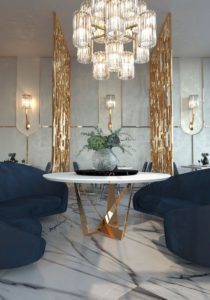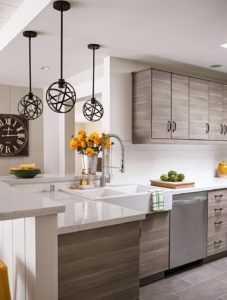The use of marble in interior design is not new. While it is definitely gaining popularity in 2019, marble has played a key role in architecture and building design for centuries. Marble seems to date back as far as the Egyptian and Mesopotamian cultures and was used to help strengthen various sculptures. In the Archaic era (700-480 BCE), sculptures of youth, called kouros sculptures, with few exceptions, were made of marble.
Let us not forget too some of the most famous marble sculptures in the world, that are still largely intact today. Michelangelo was famous for his use of marbles, carving the soft stone to create the statue of David in the early 1500s and his statue of Moses which was created between 1512 and 1515. If you have ever visited the Louvre in Paris, France, surely you have seen the lovely Aphrodite of Milos, which was made sometime around 130 to 100 BC, and is believed to represent the Greek goddess of beauty and love. While the arm and original plinth are missing, this piece still stands at the museum, boating over six feet in height.
Quite simply, marble has been used for centuries because of its beauty as well as its long-lasting strength. The use of the stone is now seen in furniture, homeware, flooring, countertops, and even lighting, not to mention more and more pieces of art.
Where does the texture of marble come from?
While marble brings many benefits, perhaps one of the most popular and fascinating is it’s cool and smooth texture. Marble, a metamorphic rock (rocks that are formed by the effects of heat, pressure, and shear upon igneous and sedimentary rocks) is found all over the world. However, most marble production comes from Italy, China, Spain, and India.

The texture of the rock comes from the visible crystals within it. Marble, a strong, but soft stone, even though its primary mineral, calcite, only has a Mohs hardness of three, it can be scratched with a metal blade. The two main influences of the colors and texture of marble come from the kind of limestone that makes up the parent rock and the kind and degree of metamorphism.
Marble as a Popular Design Trend
Both marble and the look of marble are being found all over the place, including as a design element in packaging, on iPhone covers, in jewelry, on clothing, on clocks, as web design, and even for cake design inspiration. But aside from the leveraging the sleek and elegant look of marble, real, functional marble, is also becoming more and more popular.
- Marble as a tabletop – Many homeowners have turned to the use of marble for their table tops because of their durability and long-lasting nature. Stone tabletops are popular in quartz, cast stone (cement), and marble, and preference is usually tied to price and what the purchaser can afford. Marble tabletops can be easily protected with a sealer, and should be cleaned with distilled water, or a PH-neutral cleaner.
- Marble showers – While this might seem counter-intuitive because marble is actually a softer rock, and is therefore absorbent, it has been a continued design trend to leverage marble in showers, mostly because of the clean and sleek look that it provides. Marble is easy for designers to work with, which is one reason for its popularity. Trained contractors that understand the composition of marble, will ensure that marble, especially that used in showers and bathrooms areas, is sealed with a high-quality sealer, and then maintained regularly. Further, your contractor will educate you to avoid the use of acid-based cleansers (use a PH-neutral cleaner), and to clean with a soft or nylon scrub brush, to protect the marble and its soft absorbent texture. As a note, the use of green marble in showers is a hot trend in 2019.

- Marble countertops – Many people are afraid to install a marble countertop, thinking that they are high maintenance. But in reality, while they do need to be cared for to ensure longevity and enjoyment over time, many marble countertop owners actually like the look of the aged marble that comes with time. With marble countertops, generally, there are two finishes that are used; honed or polished. A honed finish is achieved by sanding the surface to a soft, matte finish, which means less visibility of scratches. On the flip side, this means that the marble will be less bright, and more susceptible to staining due to open pores. Sealing the honed finish will help to protect the stone. With a polished finish, the marble will have a shiny look, and while it will still scratch, it will be less prone to stains. The finish will be bright and shiny, as mentioned, but this will diminish a bit over time.
- Marble flooring – Marble flooring has been in vogue for centuries. The Taj Mahal in India is made entirely out of marble, including the floors inside the building. Two to four million people visit this wonder of the world every year, and while the country invests heavily in its maintenance, the building, and floor, has been able to withstand the test of time. Bright and clean floors made out of marble have always been popular, and associated with a refined look of elegance. Unfortunately, the price tag isn’t always as popular, and thus now many ceramics manufacturers are creating ceramic tile that emulates the look of marble. Despite the cost, for those who do want to use real marble in their flooring designs, they will benefit from the elegant style, unique appearance created from the distinctness of each piece, the natural material, the translucence of the color, and the adaptability to radiant heating systems. While no flooring material can convey the regality or elegance like marble tiles, it is important to work with a knowledgeable contractor and installer that is experienced in working with marble, to ensure that the proper care is put in at the time of installation, and so that you can be properly educated on how to maintain and care for your floors going forward.
Marble, as noted throughout history, is quite timeless. If you invest in marble for your home, you can be assured that it will always be in vogue. The prevalence of design trends that capture the look and essence of marble for adoption in other uses as previously mentioned only solidifies the argument that marble is a design trend that will continue to be popular for centuries.

